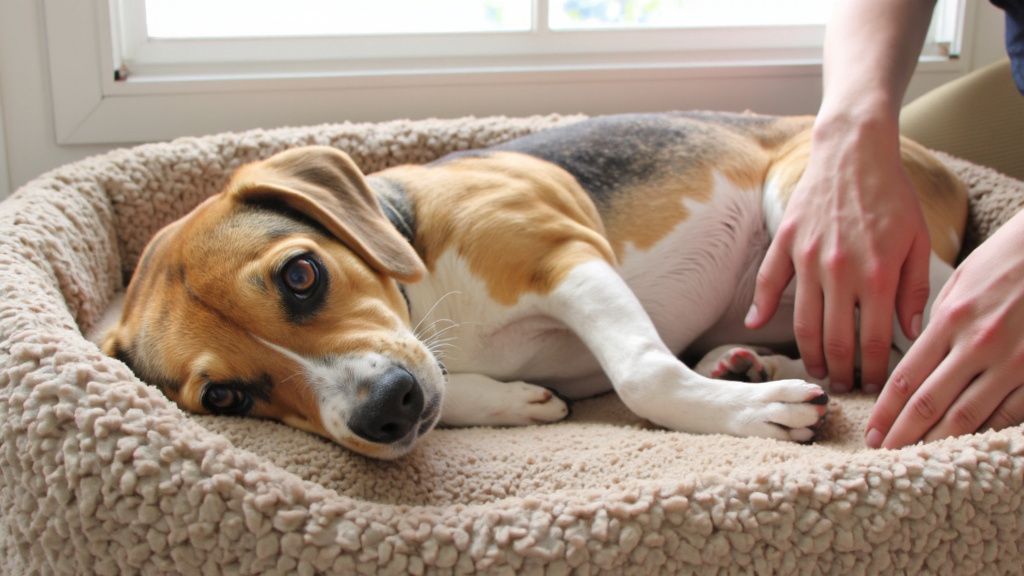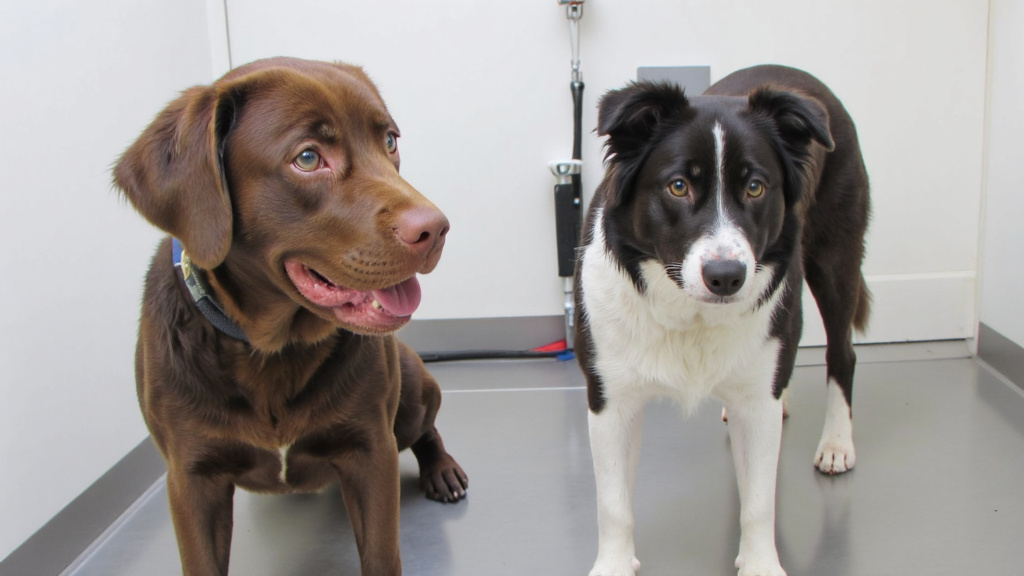
Understanding a dog’s breathing rate is a valuable yet often overlooked aspect of pet care. Like human vital signs, a dog’s respiratory rate provides insight into overall health, often signaling problems before other symptoms appear. Both new pet parents and experienced owners benefit from knowing what constitutes normal breathing to detect health issues early.
A normal dog respiratory rate typically ranges from 10 to 30 breaths per minute when resting, with smaller breeds generally breathing faster than larger ones. This baseline knowledge helps in recognizing changes that might indicate anything from stress to heart disease. The article explores how to measure a dog’s breathing, factors influencing respiratory patterns, and when variations warrant veterinary attention. These simple health checks can differentiate between routine care and an emergency situation.
What is a Normal Breathing Rate for Dogs at Rest?
When a dog is curled up on a bed, seemingly at peace with the world, the body is working at its baseline. Most healthy dogs take between 10 to 30 breaths per minute during these restful moments. This range varies slightly based on breed size—smaller dogs typically breathe at the higher end, while larger breeds often have slower respiratory rates.
Understanding a dog’s normal breathing pattern requires basic knowledge of canine physiology. Unlike humans who primarily cool through sweating, dogs regulate temperature through respiration. This difference explains why monitoring a dog’s breathing rate provides valuable insights into overall health.
How to measure a dog’s respiratory rate
Measuring a dog’s breathing rate is simple. Wait until the dog is sleeping or resting quietly, then count the number of chest rises (each rise equals one breath) over 30 seconds and multiply by two. For accuracy, perform this count when the dog isn’t actively dreaming or immediately after physical activity. The respiratory assessment protocol used by veterinary professionals follows this same basic approach when monitoring canine vital signs.
- Normal range: 10-30 breaths per minute at rest
- Potentially concerning: Consistent rates above 35 breaths per minute while resting
- Requires immediate attention: Rates exceeding 40 breaths per minute at rest
Dogs experiencing respiratory distress may show additional symptoms beyond elevated breathing rates. Labored breathing, unusual sounds, extended neck posture while breathing, or blue-tinged gums all warrant immediate veterinary care. Consistent respiratory monitoring can help catch potential health issues before they become critical emergencies.
While temporary increases in breathing rates during exercise, heat exposure, or excitement are normal, a dog’s respiration should return to baseline during rest. The American Kennel Club recommends establishing a baseline for a dog’s normal respiratory rate when healthy, making it easier to identify concerning changes if they occur.
When observing a dog’s breathing pattern, note that some brachycephalic breeds (those with flat faces like Bulldogs or Pugs) naturally have different respiratory patterns due to their unique airway anatomy. These dogs may breathe slightly faster even at rest due to their physical characteristics. Understanding a specific dog’s normal respiratory behavior helps prevent unnecessary worry while ensuring genuine breathing emergencies are identified.
How Can I Measure My Dog’s Breathing Rate At Home?

Monitoring a dog’s breathing rate provides valuable insight into their respiratory health and can alert to potential issues before they become serious. Measuring respiratory rate is something any pet owner can master with a bit of practice.
The best time to measure a dog’s breathing rate is when they’re in dreamless sleep or completely relaxed. Active dogs, excited pups, or those who’ve just exercised will naturally breathe faster, giving inaccurate readings of their baseline rate.
Step-by-Step Measurement Process
Follow these simple steps to accurately measure a dog’s respiratory rate:
- Wait until the dog is soundly sleeping or calmly resting on their side.
- Position where their chest or flank area can be clearly seen without disturbing them.
- Set a timer on a watch or smartphone for 30 seconds.
- Count each complete breath (one rise and fall of the chest equals one breath).
- Multiply the 30-second count by 2 to calculate breaths per minute.
- Record this number in a notebook or digital tracking system.
For most healthy dogs, a normal respiratory rate ranges between 15-30 breaths per minute when resting. Puppies and smaller breeds may breathe slightly faster than larger dogs. Consistent monitoring of respiratory patterns can help establish what’s normal for a specific dog.
Tools For Better Measurement
Several tools can help improve the accuracy of measurements:
- Smartphone timer apps specifically designed for pet respiratory tracking
- Traditional stopwatch for precise timing
- Notebook or calendar for consistent recording
- Digital health apps like Cardalis that can help monitor respiratory rates over time
If a dog’s respiratory rate consistently exceeds 35 breaths per minute during rest, or if there’s a sudden increase from their normal baseline, contacting a veterinarian is advised. This could indicate respiratory distress, heart issues, or other health concerns requiring professional attention.
Taking multiple measurements throughout the day can provide a more comprehensive understanding of a dog’s respiratory health. Patience is key when measuring breathing rate at home—the dog should remain undisturbed throughout the counting process for the most accurate results.
What Could Changes in Breathing Rate Mean for Your Dog’s Health?
Monitoring a dog’s breathing rate provides crucial insights into overall health. When a dog’s respiratory rate exceeds 30 breaths per minute while resting, it might signal an underlying health concern that requires attention. Dogs naturally breathe faster during play or exercise, but persistent rapid breathing at rest warrants investigation.
A healthy dog typically maintains a respiratory rate between 15-35 breaths per minute when relaxed or sleeping. To accurately measure dog breathing, count the number of chest rises over 60 seconds while calm or asleep. Establishing this baseline when the dog is healthy helps recognize abnormal patterns later.
Warning Signs That Require Veterinary Attention
Elevated breathing rates often serve as early indicators of respiratory distress or other health issues. When a 7-year-old Labrador, began breathing at 45 breaths per minute while resting, his owners noticed his gums had a slightly bluish tint. They immediately contacted their veterinarian, who diagnosed him with early-stage heart disease that required prompt treatment.
Several health conditions can trigger changes in a dog’s normal respiratory rate:
- Pain or discomfort from injury or illness
- Respiratory infections or pneumonia
- Heart problems including congestive heart failure
- Heat stress or heatstroke
- Anxiety or psychological stress
- Lung diseases or tumors
- Anemia or blood disorders
| Warning Sign | Description |
|---|---|
| Breathing Difficulty | Indicated by rapid, shallow breathing, gasping for air, or blue gums. Needs immediate action. |
| Severe Bleeding | Heavy or uncontrolled bleeding from wounds regardless of its site could signal a deeper issue. |
| Vomiting or Diarrhea | Persistent or bloody episodes can lead to dehydration and require immediate veterinary care. |
| Seizures | Lasting longer than five minutes or occurring in clusters needs urgent evaluation. |
| Sudden Collapse | Such events require immediate investigation and treatment. |
| Eye Injuries | Discharge, redness, or swelling in the eye needs prompt veterinary attention to preserve vision. |
| Unconsciousness | Sudden loss of consciousness requires rapid veterinary response. |
| Lethargy or Uncharacteristic Behavior | Sustained lethargy or sudden behavioral changes may indicate underlying serious health issues. |
| Toxic Ingestion | Consumption of substances like chocolate or certain medications can cause severe reactions. |
| Bloated Abdomen | May indicate gastric dilatation-volvulus (bloat), particularly in larger breed dogs. |
High-Risk Factors for Breathing Problems
Certain dogs face greater susceptibility to respiratory issues. Brachycephalic breeds with shortened snouts, such as Boston Terriers, Boxers, and Pugs, struggle with airflow and temperature regulation due to their facial structure. Their narrowed airways make them vulnerable to breathing difficulties even with minor exertion or slight temperature increases.
Senior dogs require closer monitoring as age-related heart and lung conditions become more prevalent. A 12-year-old Cavalier King Charles Spaniel showing subtle increases in respiratory rate might be experiencing early cardiac issues that benefit from timely intervention.
When to Contact Your Veterinarian
Seek veterinary care if any of these emergency signs appear alongside altered breathing:
- Respiratory rate consistently above 35 breaths per minute at rest
- Visible effort when breathing, including stomach muscle engagement
- Reluctance to eat, drink, or move
- Unusual gum color (pale, blue-tinged, or brick red)
- Uncharacteristic drooling or open-mouth breathing
- Breathing sounds that differ from normal panting
- Restlessness or inability to get comfortable
While occasional brief periods of faster breathing might be normal, persistent changes require professional assessment. A veterinarian can conduct an examination to determine whether the altered breathing rate stems from respiratory issues, heart problems, pain, or other underlying conditions.
How to Use the Normal Dog Respiratory Rate to Monitor Your Dog’s Health

Respiratory rate serves as a vital health barometer for dogs. By understanding what’s normal for a particular dog, subtle health changes can be detected that might otherwise go unnoticed. It acts as a dog’s personal health dashboard—a simple metric that speaks volumes about their overall condition.
A normal dog respiratory rate typically falls between 15 and 32 breaths per minute when resting. This rate varies based on breed, size, and individual factors. Small dogs tend to breathe faster than larger breeds, much like how a hummingbird’s heart beats faster than an elephant’s. This biological principle creates different baselines across the canine spectrum.
Establishing Your Dog’s Baseline
Monitor a dog’s breathing while asleep or deeply relaxed. Count one breath for each complete rise and fall of the chest. For accuracy, measure for 15 seconds and multiply by four to calculate breaths per minute. Perform this count daily for a week to establish what’s normal for the dog. This consistent monitoring reveals the dog’s personal respiratory patterns and creates a reliable benchmark for future reference.
Once this baseline is established, weekly checks become valuable early warning indicators. Dogs with cardiovascular issues benefit tremendously from this routine surveillance. Veterinary cardiologists often request respiratory tracking for dogs with heart disease, as an increasing respiratory rate often precedes clinical symptoms of heart failure.
Making Monitoring Part of Your Routine
The key to successful health tracking lies in consistency. Create a dedicated health journal where respiratory measurements exist alongside other health metrics. Several pet wellness apps now include respiratory rate trackers that remind users when it’s time to check and record the dog’s breathing. Some apps even count for users while watching the dog’s chest movements.
Calendar reminders can prompt weekly check-ins, helping integrate this health practice into regular pet care routines. The partnership between attentive owners and veterinarians becomes particularly powerful when supported by objective data collected over time. Observations provide crucial context for veterinary diagnosis during chronic illness management.
When to Contact Your Veterinarian
Contact a vet if the dog’s resting respiratory rate consistently exceeds 30-35 breaths per minute or if there’s a sustained increase from the established baseline. Sudden changes warrant prompt medical attention, especially when accompanied by labored breathing, unusual posture, or changes in gum color.
Regular respiratory monitoring empowers active participation in a dog’s healthcare. By tracking breathing patterns, medical intuition about the pet is developed that complements professional veterinary care. This systematic approach to dog health surveillance transforms routine observation into valuable medical intelligence that can potentially save the dog’s life.
Normal Dog Breathing Rate: Final Thoughts for Caring Pet Owners
Monitoring a dog’s breathing rate at rest offers a proactive approach to detecting potential health concerns early—often before noticeable symptoms arise. Cultivating a habit of regular respiratory checks equips dog owners to recognize subtle shifts in their pet’s well-being and make informed decisions about veterinary care. Tools like the Halo Collar add another layer of insight, providing real-time tracking and helping ensure a dog’s safe, stress-free environment—both fundamental to steady, healthy breathing. Consistent observation, paired with supportive technology, gives dogs the best chance at long-term health and happiness.
Explore more expert tips for safeguarding your dog’s wellness by visiting the Dog Health page.






